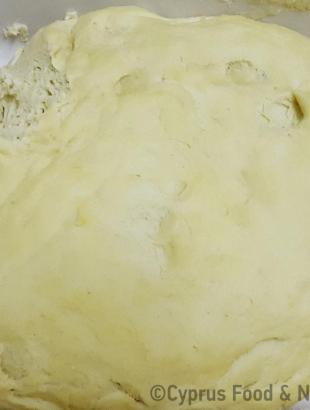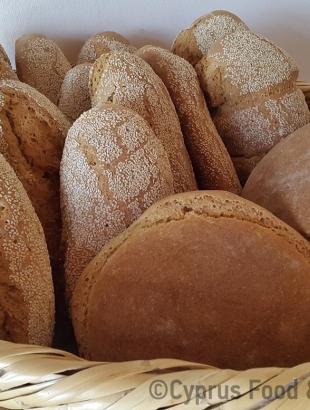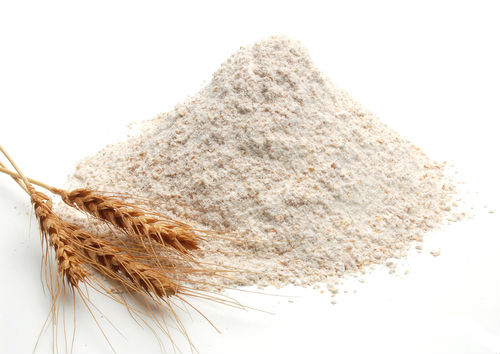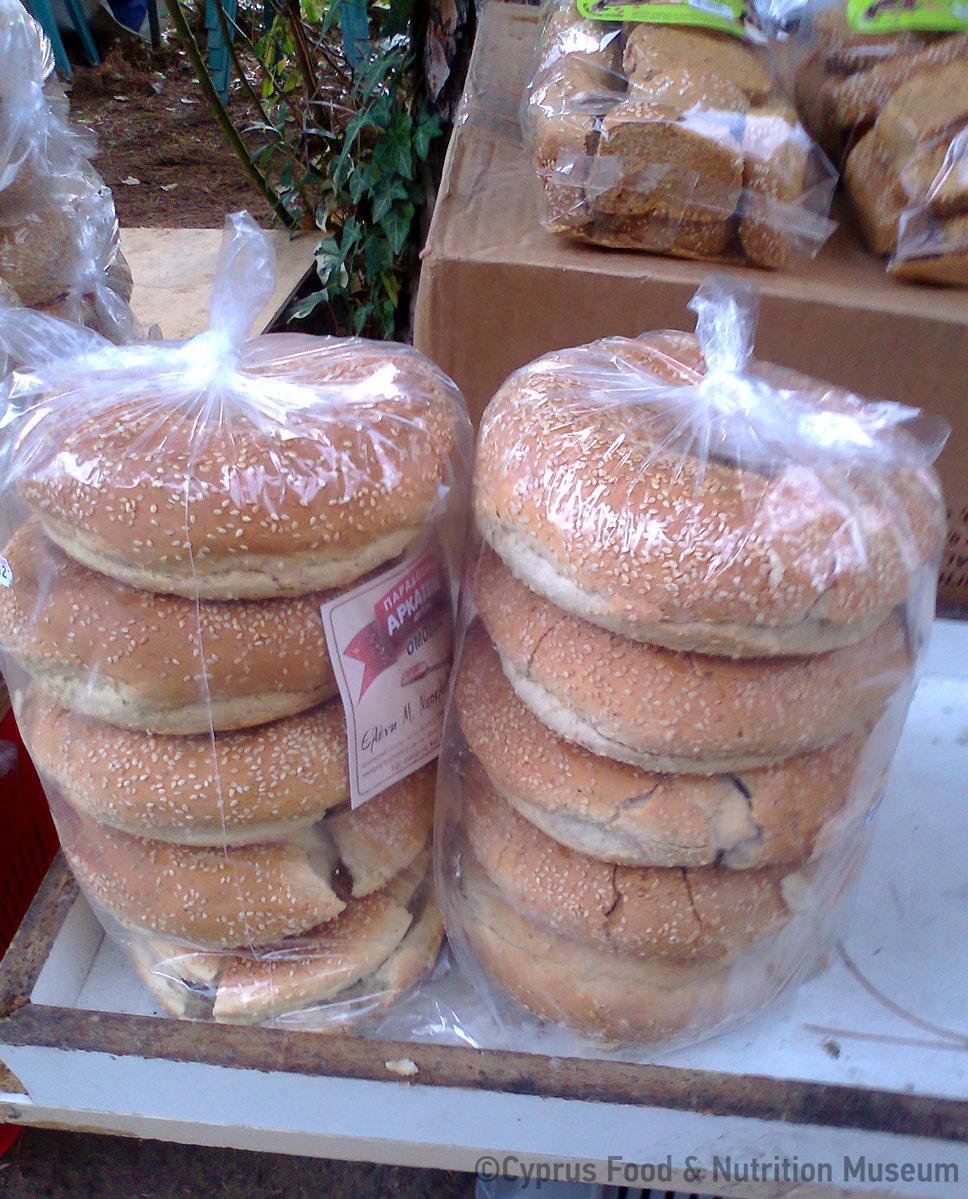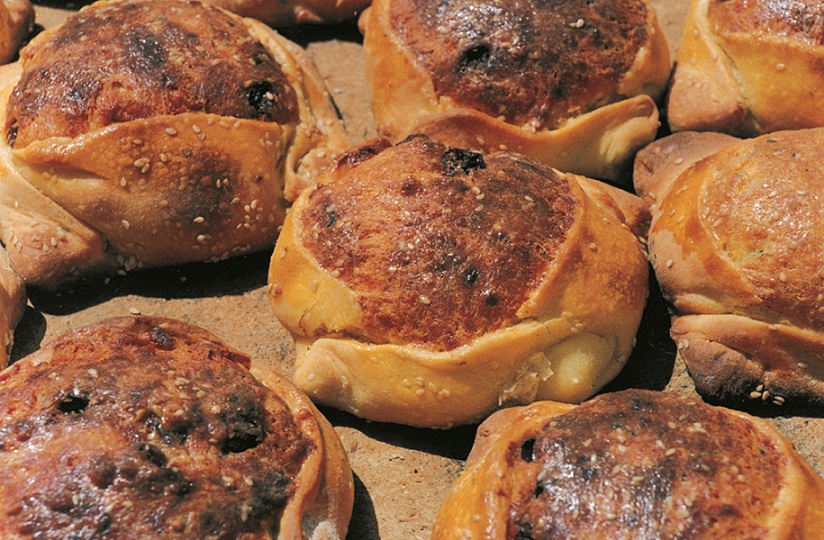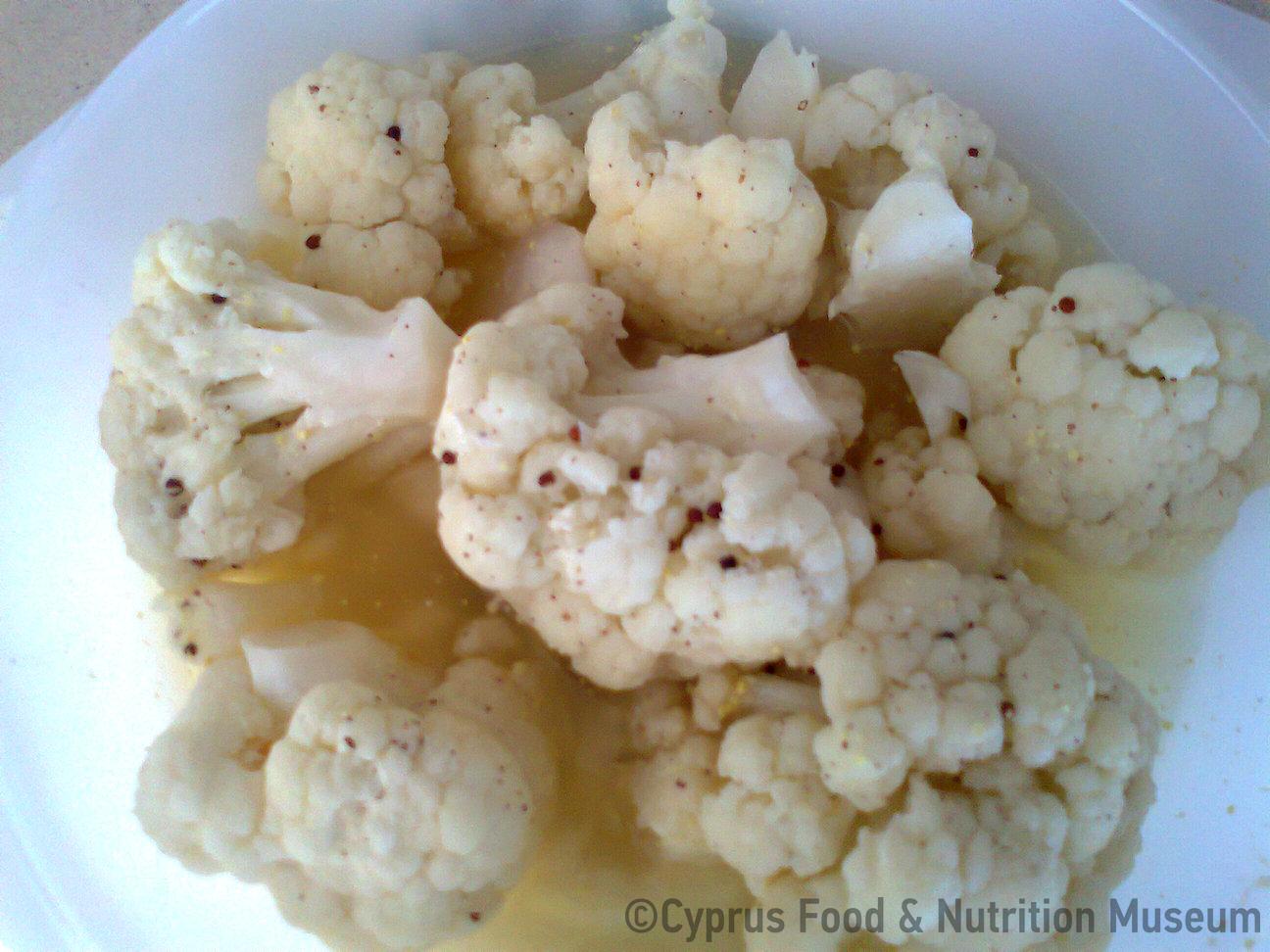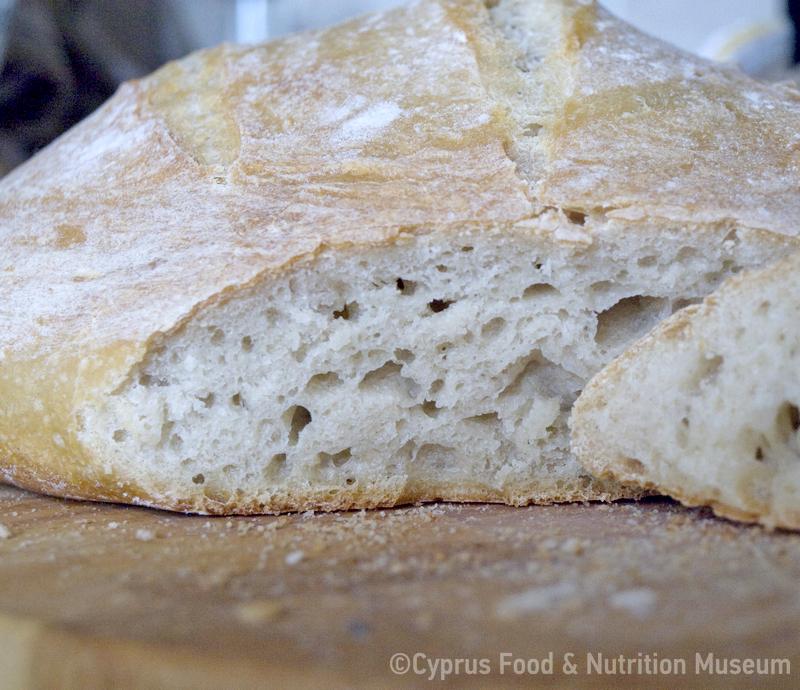In the old days the sourdough was kneaded in the wooden basin and kept in a special pot, which contained flour.
Name - Recipe
Προζύμι. Sourdough is a fermented dough used in the preparation of new dough.
It is a small amount of dough (usually for bread) from a previous kneading that is allowed to ferment and is used to make new dough (Wiktionary. The Free Dictionary, «προζύμι»).
According to Kypri - Protopapa (1997, 19), it is a piece of acidic dough which had undergone fermentation and which was used as the basis of the dough, in order to make the various types of dough to rise and become fluffy.
Version A:
3 tsp of rosewater
3 tsp of holy water (on 14 September, when the Exaltation of the
Cross is celebrated, we get holy water from the church)
3 tbsp of wheat flour (if more is needed, add more)
Version B:
one part of holy water
2 parts village (hard) flour
A little salt
Version A:
The preparation of the sourdough takes seven days and is done, according to the customs, at about the same time every day. Day 1: In a small bowl, place the rosewater, the holy water and the flour. Stir and knead the ingredients until the dough is firm and has the size of a marble. Cover it with some flour and let it rest. Day 2: Using a knife, remove the dry parts around the sourdough and with the aid of a little water, dissolve the sourdough and supplement with flour until the dough is firm and cover it with flour on top and let it rest. Day 3: Using a knife, remove the dry parts around the sourdough and with the aid of a little water, dissolve the sourdough and supplement with flour until the dough is firm and cover it with flour on top and let it rest. Follow the custom and soak the dry parts that you have collected during these two days in water and add some flour to make a pitta that you will bake to have a good year. Day 4: Using a knife, remove the dry parts around the sourdough and with the aid of a little water, dissolve the sourdough and supplement with flour until the dough is firm and cover it with flour on top and let it rest. Day 5: Using a knife, remove the dry parts around the sourdough and with the aid of a little water (5 tablespoons), dissolve the sourdough and supplement with flour until the dough is firm and cover it with flour on top and let it rest. Day 6: Using a knife, remove the dry parts around the sourdough and with the aid of a little water (5 tablespoons), dissolve the sourdough and supplement with flour until the dough is firm and cover it with flour on top and let it rest. On this day, the process is completed and the sourdough has the size of an orange. Day 7: Knead the prosphoro (testimony of Flourou K. Parpouna, 80 years old, Lysi - Famagusta).
Version B:
Traditionally the Great Holy Water from Epiphany day was used or from the Exaltation of the Holy Cross. In a bowl, pour holy water and add village flour and knead it. The dough should not stick to your hands, but should be soft. Place the dough in a cup after rolling it in flour and cover with a clean towel. Place a woolen cloth over it, so that it remains relatively warm and facilitates the fermentation. After three days, add a little more holy water and village flour to the dough. Knead the dough and cover it in the same way as before. After three days, add the last part of the holy water, add more village flour, knead and cover it in the same way as before. After three more days the sourdough is ready. Keep the sourdough in the freezer. In the past, it was stored in the flour pot. Part of it will be used in the next sourdough. In this manner, the sourdough is preserved and renewed throughout the year.
"Every housewife always had some sourdough in the house. This sourdough was renewed every time she would knead by adding a little flour and lukewarm water, kneading it and crossing it, covering it with a white cloth for a few hours to rest" (Kypri - Protopapa 1997, 19).
'For the preparation of the new sourdough, many traditional methods are mentioned. The notion that the new sourdough should be made using holy water obtained from the church on the day of the Exaltation of the Holy Cross feast, on 14 September, is very widespread" (Kypri - Protopapa 1997, 21)
“In the old days, sourdough was kneaded in the wooden basin and stored in a special jar which contained flour. Today my grandmother keeps it in a bowl where she places a tissue on top and covers it with a towel. She then places it in a nylon in which she pokes a few holes and stores it in the refrigerator. Grandma Flourou still makes sourdough and uses it as a raw material to make prosfora, bread, dahtilies, rusks and pittas such as the vasilopitta and yennopitta. She learned this process from her mother and has kept it unaltered to this day. But now that there is ready-made bread and people are not able to knead because of other obligations, my grandmother makes sourdough bread once a week. She makes prosfora and other preparations with sourdough only at memorial services and festivities” (Christiana Parpouna - Testimony of Flourou K. Parpouna, 80 years old, Lysi - Famagusta).
'The sourdough was usually prepared in a small wooden basin, that they called vournin. They would never use up all the sourdough but they would always keep a small piece for their next dough. They would store this piece in a small container with a little salt and flour to preserve it' (Kypri - Protopapa 1997, 19).
Functional and symbolic role
Sourdough is used as the " leavening" material for traditional baked goods (prosphora, bread, dahtilies, rusks and pittas such as the vasilopitta and yennopitta).
Sourdough was previously the only means of leavening bread and other baked dough preparations.
“Sourdough was considered so valuable and necessary for a household that in many villages of Cyprus the mother of the bride would put some sourdough in her daughter's bosom on her wedding day. Evidence of this is found in many villages, such as Lapithos, Marathovouno, Lefkoniko, Kalopsida, Asomatos, etc. A testimony has been given from Kalopsida that 'the sourdough was placed on the bride's bosom with a comb'. Motides mention that the sourdough was given to the bride by her father. Another related custom, recorded from Saint Ambrosios, was that at the wedding ceremony, they would place the sourdough in a tats̆ian (a sieve with a silk base) together with cotton seeds and wheat and take it to the church. At the church, it was customary to throw the seeds to the couple during the Isaiah dance and leave the sourdough behind to be taken home. In Kalograia, the mother of the bride would walk in front of the other people holding the tats̆ian with the sourdough wrapped in a clean towel. If the mother was not alive, her sister or godmother would take it. In general, the custom of giving sourdough on the wedding day was symbolic of the establishment of the new home. It was an essential indication towards the bride of her new responsibilities and duties, in accordance with the traditional values of the Cypriot society. At the same time it was also a wish that the new home would always have food supplies” (Kypri - Protopapa 1997, 20-21).
In the past, sourdough was the only leavening agent for lokoumades, which were usually made during major religious festivals and on the eve before and on the day of Epiphany.
The considered sourdough as something sacred, as God's blessing for their house. That is why they prepared it with religious reverence and kept it as something very important, as it was indeed, since it would be used to make bread, the main item of their daily diet, as well as the bread and prosfora for the church (Kypri - Protopapa 1997, 19-20).
Additional information and bibliography
“The notion is common to all that the woman who will receive holy water, in order to make new sourdough, must necessarily be clean, must be free of menstruation and must not have had intercourse with her husband for at least the last three days. That is why in some villages, as in Lapithos, the holy water was given to girls under twelve years of age or to old women, who had no sins and were pure. They were the ones who kneaded the new sourdough, and only when the sourdough was 40 days old, could the other women take it. But when they were also kneading bread for the church or service, they too had to be clean” (Kypri - Protopapa 1997, 22).
Kypri Th. - Protopapa K. (1997), Traditional bread and pastry preparations of Cyprus. Their use and significance in customary life, Publications of the Centre for Scientific Research, XVIII, Nicosia.
Web sources: Wiktionary. The Free Dictionary, «προζύμι», https:// el.wiktionary.org/wiki/προζύμι. Community Council of Limnatis, 'Traditional products', http:// www.limnatis.org/index.php?lang=el&article=11.
Oral testimonies: Maria Enotiadou, 63 years old, Vatyli - Famagusta. Recording: Stalo Lazarou, 2010. Maroula Economidou, 85 years old, Pedoulas - Nicosia. Recording: Stalo Lazarou, 2010. Flourou K. Parpouna, 80 years old, Lysi - Famagusta. Recording: Christiana Parpouna, October 2010. Edited by Stalo Lazarou.
Christiana Parpouna / Stalo Lazarou, Argyro Xenophontos
